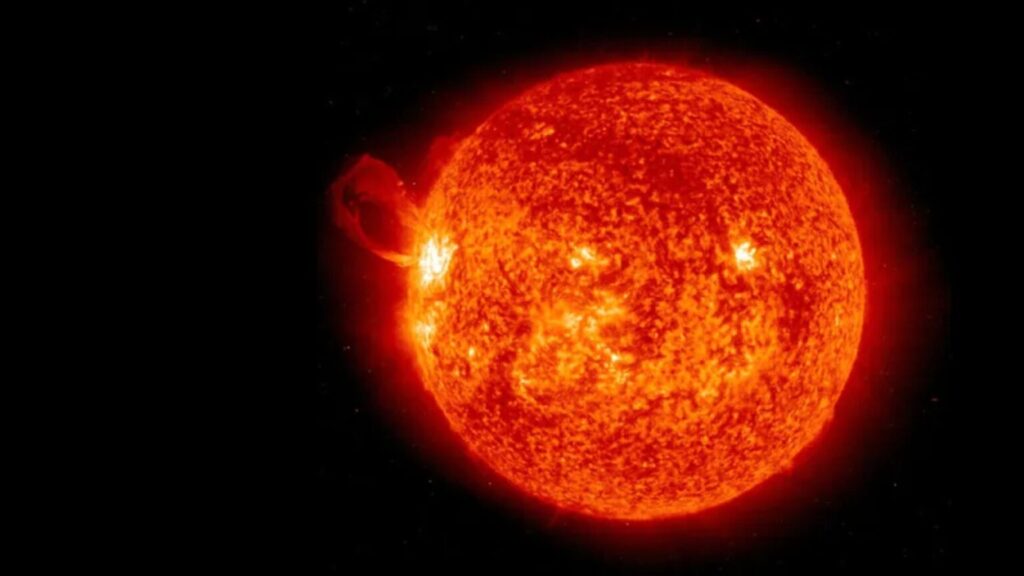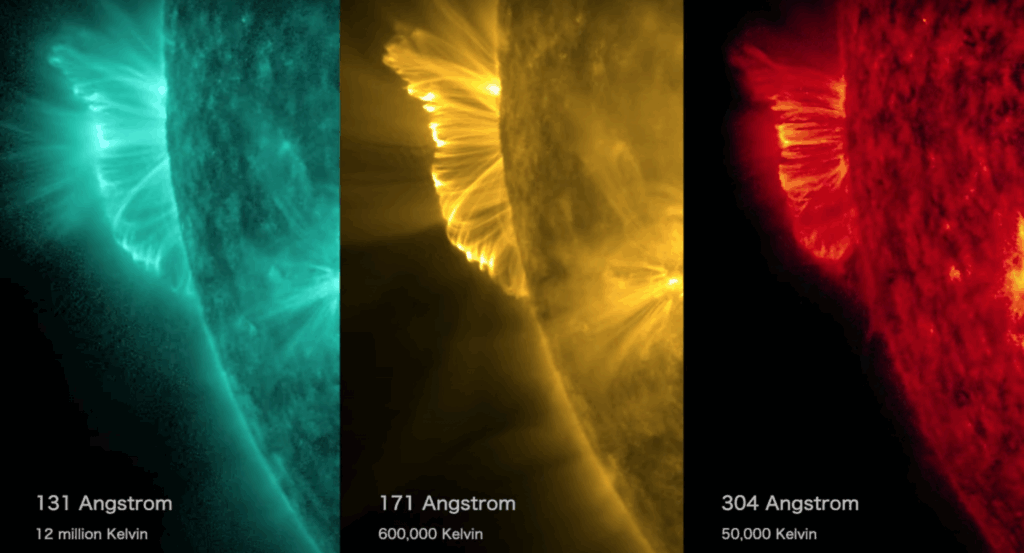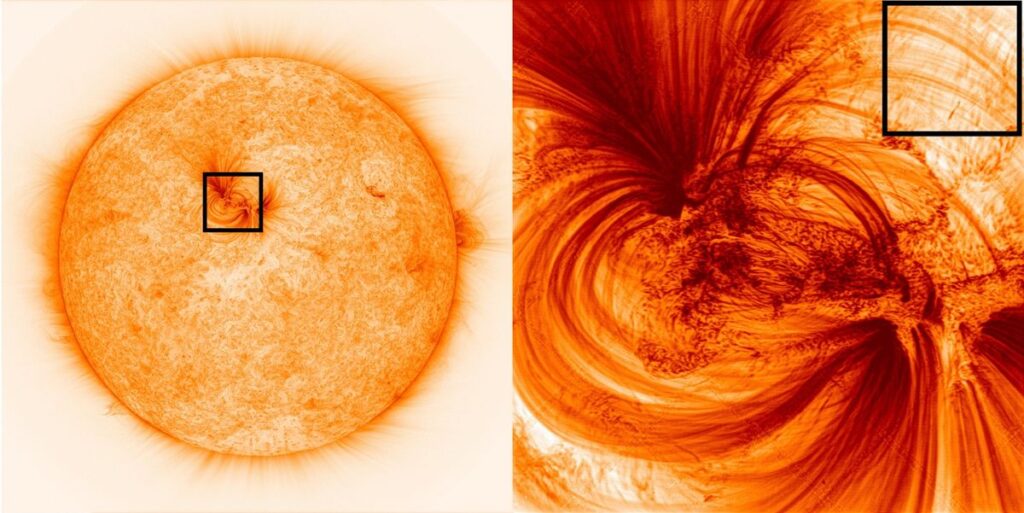
NASA Just Discovered Solar Curtains on the Sun: NASA has just unveiled a groundbreaking discovery on our Sun: ultra-thin plasma structures dubbed “solar curtains.” These tiny, ribbon-like features—only about 12–20 kilometers wide—have never been seen before. They were spotted by the Daniel K. Inouye Solar Telescope (DKIST), the most advanced solar telescope on Earth.
This isn’t just space eye candy. These fine, magnetic plasma sheets may hold the key to understanding how energy builds and releases in the Sun’s atmosphere, potentially triggering solar flares and space weather events that affect satellites, power grids, and radio signals here on Earth. Let’s break down what these solar curtains are, why they matter, and what this discovery means for all of us.
NASA Just Discovered Solar Curtains on the Sun
The discovery of solar curtains is more than just a cool visual—it’s a scientific milestone. For the first time, we’re seeing the Sun’s magnetic heartbeat at the tiniest scales ever recorded. With the power of DKIST, scientists now have the tools to understand how small magnetic events can trigger massive consequences for Earth and beyond. From protecting satellites to understanding the universe’s fundamental forces, this is one discovery that pulls back the curtain—literally—on the Sun’s inner workings.
| Feature | Details |
|---|---|
| Discovery | Ultra-thin solar curtains—magnetic plasma striations |
| Spotted by | Daniel K. Inouye Solar Telescope (DKIST) in Maui, Hawaii |
| Curtain width | Approximately 12–20 kilometers |
| Instrument used | Visible Broadband Imager (VBI) in the G-band spectrum |
| Magnetic field interaction | Stronger fields = brighter regions, weaker fields = darker stripes |
| Additional findings | Microflares—explosive bursts of energy about 700 km wide |
| Scientific importance | Reveals fine-scale magnetic field variations that affect solar activity |
| Practical implications | Improved forecasting of space weather and solar flare risk |
| Official source | Visit DKIST at NSO.edu |
What Are Solar Curtains?
The Sun’s surface isn’t flat. It’s made up of boiling plasma convection cells called granules—each about 1,000 kilometers across. Along the edges of these granules, scientists have now observed what they describe as curtains of plasma—alternating bright and dark stripes shaped by complex magnetic fields. These solar curtains are incredibly narrow, with widths of only about 12 to 20 kilometers.
These bright and dark stripes represent varying magnetic field strengths. Where the magnetic field is stronger, the plasma appears brighter. Where it is weaker, it appears darker. What makes this so important is that this structure—called striated granulation—has been theorized in models, but never observed at this resolution before.

How NASA Captured the Solar Curtains?
The discovery was made using the Visible Broadband Imager (VBI) aboard the DKIST telescope. DKIST is situated atop Haleakalā, a dormant volcano in Maui, and is equipped with a 4-meter mirror—the largest ever used for solar observation. With a resolution of 0.03 arcseconds, it can capture features on the Sun as small as 20 kilometers wide.
To put that into perspective: this is like seeing a nickel from 60 miles away.
The VBI was focused on the G-band spectrum—a part of visible light that’s especially useful for detecting magnetic features. By capturing rapid sequences of high-resolution images, DKIST created a time-lapse view of these plasma structures evolving in real time.
A Hidden World Revealed: Striated Granulation
For decades, scientists have suspected that small-scale magnetic structures existed on the Sun’s surface but lacked the tools to see them. DKIST changed that.
These striations—what we’re now calling solar curtains—are aligned with the edges of solar granules. As hot plasma rises from the Sun’s interior and cools at the surface, it sinks back down in a convective process. Along those downflow lanes, magnetic fields are stretched, compressed, and twisted into alternating regions of intensity.
The result is a striped pattern—similar to venetian blinds fluttering in the wind—that subtly shifts the height of the visible solar surface. These micro-depressions, known as Wilson depressions, can change the elevation of the photosphere by a few kilometers.
What Else Was Discovered? Microflares and Magnetic Reconnection
While observing these curtains, researchers also spotted another fascinating event: microflares. These are tiny but intense explosions of magnetic energy, about 700 kilometers wide—roughly the size of Rhode Island.
Each microflare can release the energy of 10 billion lightning bolts, and plasma from these explosions can travel at 20 kilometers per second. Scientists believe these occur when magnetic fields of opposite polarity collide and reconnect—a process called magnetic reconnection.
While microflares are far smaller than massive solar flares or coronal mass ejections (CMEs), they still matter. In fact, some researchers think that countless microflares may help explain the mystery of coronal heating—why the Sun’s outer atmosphere is hotter than its surface.
Why Does NASA Just Discovered Solar Curtains on the Sun Matter for Earth?
It’s easy to think of the Sun as distant and disconnected from daily life, but the truth is, we are deeply connected to solar activity. The magnetic fields behind these solar curtains may be precursors to much larger events.
When magnetic energy builds up and is released, it can create solar flares or CMEs. These events blast charged particles into space, which can:
- Knock out power grids
- Interfere with GPS and communication satellites
- Force airlines to reroute flights
- Endanger astronauts on the ISS
- Disrupt military and maritime navigation systems
Understanding how small-scale magnetic fields behave on the Sun gives us a head start in predicting and mitigating these problems.

Step-by-Step: How Solar Curtains Form
- Heat Rises from the Solar Interior
Deep inside the Sun, nuclear fusion generates intense heat. That heat rises through convection, forming large boiling granules. - Magnetic Fields Get Twisted and Concentrated
As the plasma moves, it carries magnetic fields with it. These fields bunch up along granule walls. - Striations Develop Along Plasma Downflows
Alternating strengths in the magnetic field create visible light and dark lines—our solar curtains. - Energy Builds and Can Trigger Microflares
In some regions, opposing magnetic fields collide, triggering microflares that release intense energy in a short time.
Real-Life Analogy: A Lava Lamp Meets a Magnet
Imagine a lava lamp filled with glowing goo. Now imagine the inside is lined with invisible magnetic wires that stretch and squeeze the lava into ribbons. That’s what’s happening on the Sun—but at thousands of degrees, and with energy levels we can barely comprehend.

Implications for Science, Technology, and Society
For Scientists:
This opens a new frontier in magnetohydrodynamics—the study of plasma and magnetic fields. We now have the ability to test long-held theories with direct observation.
For Engineers:
Better understanding of magnetic field behavior helps aerospace and telecom engineers design more resilient satellites and communication systems.
For Educators:
This is an incredible opportunity to inspire the next generation of physicists and engineers. High-resolution images and time-lapse videos make complex phenomena accessible for K-12 and college students alike.
For Policy Makers:
Improved solar monitoring can influence funding for space weather preparedness, including safeguarding infrastructure like power grids and undersea cables.
Starlink in Trouble? Solar Storms Disrupt Elon Musk’s Satellite Network
Confirmed: Black Hole Detected Spinning at Blistering 80% of Its Max Speed—What It Means for Physics











